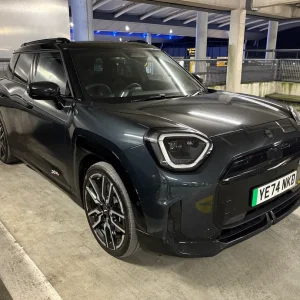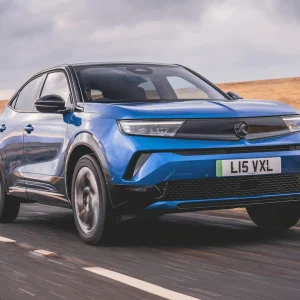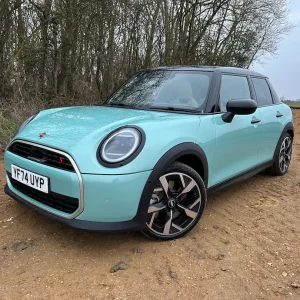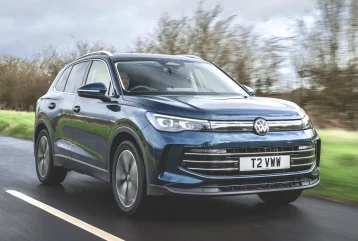
Impressively, Volkswagen has shifted over 7.5 million Tiguans over the previous two generations and 16 years. Perhaps feeling the heat from more modern, premium medium rivals, the look and feel of the new Volkswagen SUV is itself more polished and premium – just like the BMW X1, the current holder of our Best Premium Medium SUV award. The Tiguan already felt more upmarket than rivals such as the Nissan Qashqai, but it wasn’t quite up to the level of the Audi Q3.
The first sign of Volkswagen’s intention to go more premium can be seen in the Tiguan’s styling, with similarities with the bigger Touareg (especially around the rear). This surely can not be coincidental. However, despite being more distinctive than the old car, sadly the design is no more interesting.
From the front, the design highlight must be the optional IQ headlights, with the thin light bar, and sealed top grille, with the latter made up for by the large front grille in the lower front air dam. There is some neat texturizing down the lower flanks at the sides. The rear highlight, like the front, is another high-set light bar made up of the LED taillights. Altogether, this Tiguan is much sleeker than before, with its 0.28 Cd figure.
Built on Volkswagen’s MQB Evo platform, the result is the Tiguan is now 30mm longer, but the width and wheelbase remain unchanged. However, the boot space of eTSI, TSI, and TDI diesel models has grown by 37 litres, to 652 litres. And while there’s no more legroom, headroom has been improved by 9mm at the front and 10mm in the rear. Space and legroom feel plentiful in the front and rear of this Volkswagen. Choose the incoming eHybrid plug-in hybrid versions, which fleets probably will, and they lose 162 litres of space thanks to the higher load area.
Interior progress
Volkswagen’s trim and materials have always been top-notch, but the latest Tiguan appears to have pushed this further forward. The dashboard highlight is the infotainment touchscreen, which we tried in 12.9in form, in our R-Line trim test car – but it is also available in a 15.0in version. The screen works similarly to those we’ve previously tried in the Passat and ID.7. The graphics are some of the best in class, but the small icons can be difficult to touch on the move.
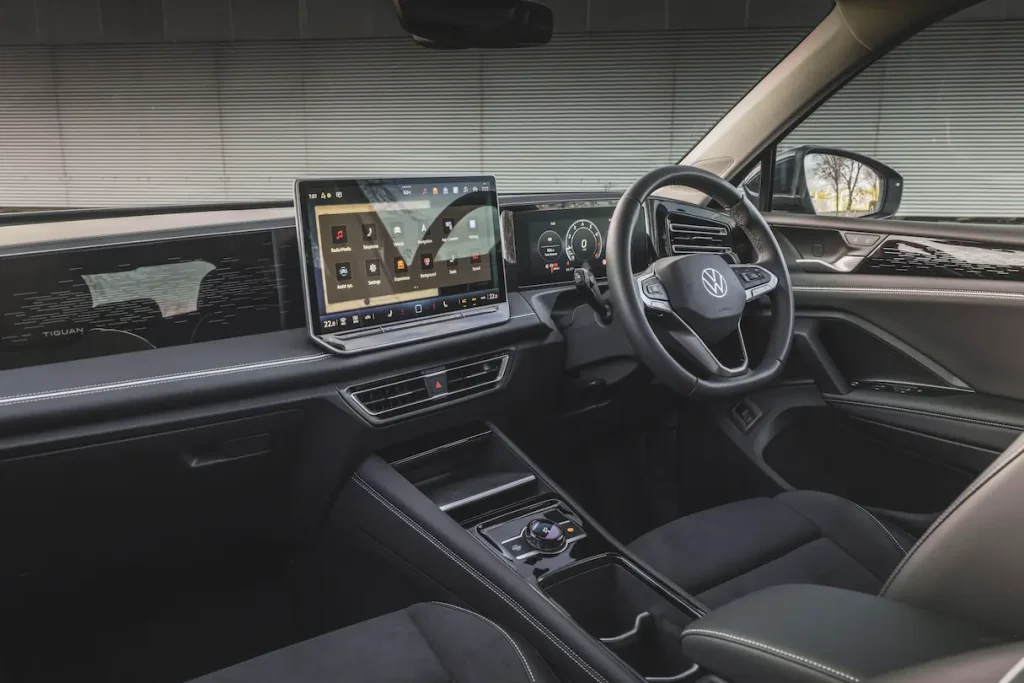
Elsewhere, there is another multi-function controller in the centre console, just like the new Passat, which is mostly to operate the infotainment and drive modes. Like the Passat, all Tiguans are auto-only, with the gear selector on the steering column, the same as fitted to Volkswagen’s ID EV models freeing up space in the centre console.
We got to try one of the seven engines that will be offered in the Tiguan. The 148hp version of the 1.5-litre eTSi with 48-volt mild hybrid tech, is smooth enough, but is torquey (184 lb ft) rather than particularly powerful.
There is also a 128hp version of the 1.5-litre eTSi, but the two new incoming eHybrid engines that will be more appealing to fleet drivers, are available in 202 and 270hp versions. They also use the 1.5 TSI petrol engine, which is combined with a much larger 19.7kWh battery, with the promise of more than 70 miles EV-only range.
Other good news is that when the eHybrids need electricity, they can be charged at DC rapid charging stations at up to 50 kW, equalling 10 to 80% in around 23 minutes.
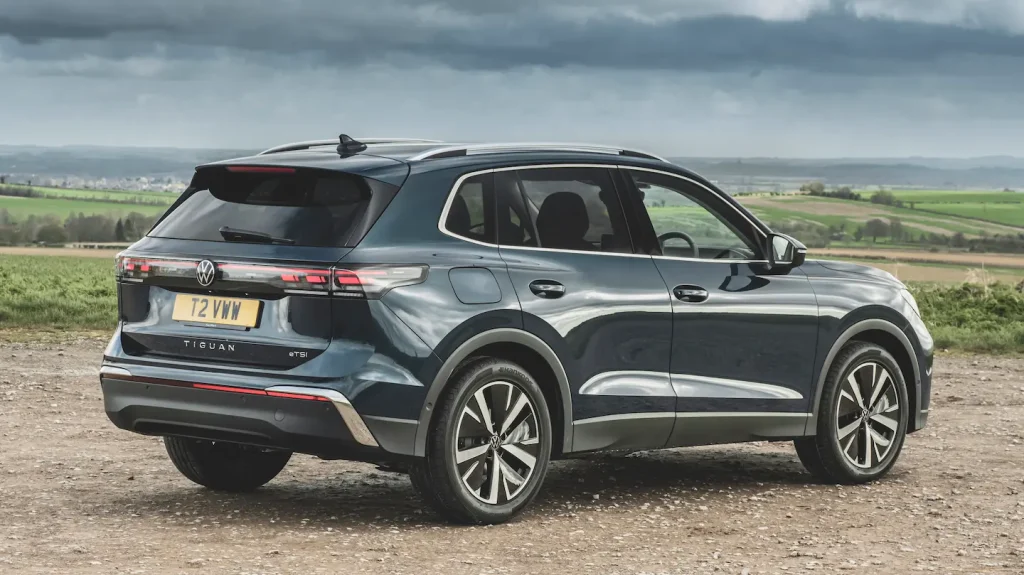
On the road, our R-Line spec was fitted with 20in wheels, with optional Dynamic Driving Package – which includes DCC Pro adaptive dampers. ‘Comfort’ mode is noticeably softer and most comfortable. With ‘Sport’ the firmest setting.
The new Tiguan impresses with its overall refinement, and interior space. What this Volkswagen lacks in driver appeal, it makes up with being so easy to live with.
Positive: Attractive and spacious interior, low running costs for PHEV versions, impressive infotainment.
Negative: Pricey – especially PHEV versions, infotainment difficult to use on the move, ChatGPT a gimmick for now.
Standard equipment: 17in ‘Bari alloys, 12.9in central infotainment display with integrated Sat Nav, 10.25in Virtual Cockpit, Quad Paper fabric upholstery, LED front and rear lights.
Engines: Petrol: 128hp 1.5, 148hp 1.5; Plug-in hybrid: 202hp 1.5, 270hp 1.5; Diesel: 148hp 2.0
Equipment grades: Life, Elegance, R-Line
Transmissions: Seven-speed auto
Model: Volkswagen Tiguan R-Line 1.5 eTSI 150
P11D: £39,380
Residual value: 49%
Depreciation: £19,480
Fuel: N/A
Service, maintenance and repair: £3,180
Cost per mile: N/A
Fuel consumption: 41.5-43.5mpg
CO2 (BIK %): 149g/km (34%)
BIK 20/40% a month: £223/£446
Luggage capacity: 652 litres
Engine size/power: 1,498cc/148hp
Score: 8/10
| Model | Volkswagen Tiguan R-Line 1.5 eTSI 150 |
| P11D | £39,380 |
| Residual value | 49% |
| Depreciation | £19,480 |
| Fuel | N/A |
| Service, maintenance and repair | £3,180 |
| Cost per mile | N/A |
| Fuel consumption | 41.5-43.5mpg |
| CO2 (BIK%) | 149g/km (34%) |
| BIK 20/40% a month | £223/£446 |
| Luggage capacity | 652 litres |
| Engine size/power | 1,498cc/148hp |
| Score | 7/10 |

